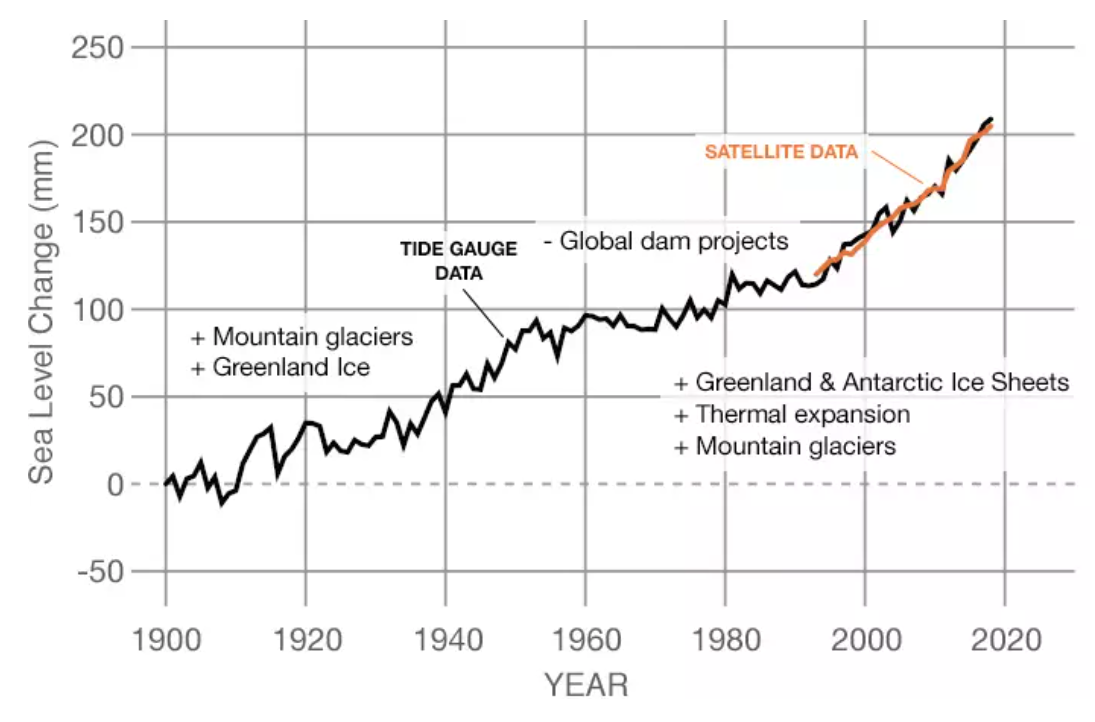Why Does Sea Level Rise and Fall?Why Does Global Sea Level Have Temporary Ups and Downs?
Global mean sea level is the average height of the world’s oceans. It has been steadily increasing over the past century, primarily due to two major factors: the thermal expansion of ocean water as it warms and the addition of water from melting ice sheets and glaciers. This long-term rise is a clear indicator of ongoing climate change, driven by human activities that add greenhouse gases to the atmosphere.
Despite this clear upward trend, global mean sea level does not increase in a perfectly linear fashion. It exhibits temporary ups and downs due to various natural phenomena and seasonal variations. One that is very noticeable is an annual cycle that results from changes that happen in our climate over the course of a year. In each hemisphere the oceans warm and expand in summer, and cool and contract in the winter. Sea levels in each hemisphere are higher in summer and early autumn, and lower in winter and early spring. In addition, there is an increase of water stored on land in the Northern Hemisphere winter and thus less in the ocean, leading to a lower global average sea level at this time of year. While these annual changes happen at different times of the year in each hemisphere, they average together to a noticeable shift in globally averaged sea level over the course of the year. In the global average, this shift is around 1 inch (2 cm) on average, although the annual cycle can be much larger in local sea levels.
At time periods slightly longer than seasons, naturally occurring climate variations can also cause changes in global mean sea level. For instance, El Niño and La Niña events can temporarily elevate or lower sea levels by affecting ocean temperatures and currents. During an El Niño event, the ocean temporarily warms on average and there is a net transfer of water from land and into the ocean due to shifting precipitation patterns. This leads to higher global mean sea level. The opposite happens during a La Niña and global mean sea level can actually drop.
We can see the interplay between long-term sea level rise, the annual cycle and El Niño by looking at satellite altimeter measurements. The animation shows the rise in global mean sea level from 1993 to 2023 based on data from a series of five international satellites. The data over the course of each year in the record is displayed. The annual up-and-down is visible - global mean sea level is a little bit higher from August to October, for example - as are the temporary spikes in sea level due to El Niño and La Niña. The spikes in sea level from 2015 to 2016 and from 2022 to 2023 result from El Niño, while the noticeable drop from 2010 to 2011 is caused by La Niña. Despite these variations, the upward trend in global mean sea level is dominant and sea levels are roughly 4 inches higher today than they were in 1993.
The Impact of Dam BuildingShort-Lived But Significant Impact of Dam Building
In the mid-20th century, the construction of large dams significantly impacted global mean sea level. These massive engineering projects, primarily aimed at water storage, flood control, and hydroelectric power generation, led to substantial alterations in the natural flow of water between ocean and land. By trapping large volumes of water in reservoirs, dams effectively reduced the amount of freshwater reaching the oceans, which suppressed global mean sea levels. This impact was particularly pronounced during the peak dam-building era from the 1950s to the 1970s. The cumulative effect of numerous dams around the world contributed to a temporary flattening of global mean sea level rise, counteracting the sea-level rise driven by ice melting and thermal expansion of seawater. Nevertheless, this was only temporary, and since around 1970, we’ve seen a sustained period of increasing global mean sea level that can be explained by the combination of thermal expansion and ice melt. Tracking the drivers of global sea level rise is critical to understanding shifts that we see and can help inform what we know about sea level changes in the future.
